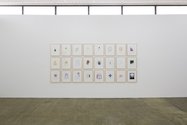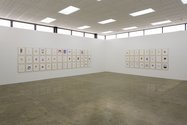John Hurrell – 22 March, 2014
There are three different components in this exhibition from esteemed Austrian artist Peter Friedl, and they are cleverly positioned so that a ‘left eye’ of four peering marionettes and a ‘right eye’ of Friedl himself (as author of a suite of ninety playful drawings of ‘historical’ portraits that take up the main Artspace gallery) gaze through two open doorways towards a row of six constantly changing projections of children’s playgrounds.
Let’s start a speculative interpretation by looking down on this show - I mean in cross-section - imagining the floorplan of the gallery as a diagrammatic slice through the human skull, halfway down, level with the eye sockets.
There are three different components in this exhibition from esteemed Austrian artist Peter Friedl, and they are cleverly positioned so that a ‘left eye’ of four peering handcrafted marionettes (Julia Schucht, Tousssaint Louverture, John Chavafambira, and Henry Ford) and a ‘right eye’ of Friedl himself (as author of a suite of ninety playful drawings of ‘historical’ portraits that take up the main Artspace gallery) gaze through two open doorways towards a row of six constantly changing projections of children’s playgrounds, Friedl’s archive of over a thousand photos taken in various cities and small towns in several continents.
In a search for meaning it might be argued that it is impossible to seriously analyse oneself by scrutinising one’s own play (whether as imagined/recollected child or as creative ‘artistic’ adult), and indeed, the ‘right eye’ is blind in that it only sees dark walls (see image 2). Unlike the left (image 1) - or is this only facile punning on political conviction, with ‘left/right’ being absurdly literal, symbolic and didactic?
The constantly changing documented playgrounds remind us that they function as a method of helping children learn to coordinate their movement, exploring the physical contingencies of an environment safely under adult supervision. These settings help them gain confidence and independence whilst learning to socialise, having fun with speed and spatial coordination - before the discovery of, say, wheels on bikes and carts. Friedl’s varied photos reveal a range of socio-economic settings (each obviously with their own history) through the purchasable types of equipment, paths or landscaping on view, or through the state of adjacent buildings (if any).
Friedl‘s drawings, in a variety of media, play a different role. They appear to be more about motor processes and manual actions that prod the mind, an implied means of reflecting on historic backstories instead of a striving for ‘realistic’ representation. There are lots of portraits, often of individuals participating in liberation movements, or Marxist philosophers, who have had their photographs in newspaper media, or of people Friedl knows personally (they appear more intimate). There is a nice loose quality to the rendered physiognomies that includes pencil tracings as often as freehand sketches - a symbolic dimension referring to the transferral of ideas perhaps. The images are borne of contemplation, a linking of muscularity by rote with a directed interiority linked to reading. In a sense they are ‘action’ drawings, and are performative in the sense of mentally ‘drawing out’ certain biographical narratives from carefully rendered visages.
The four marionettes seem chosen out of Friedl’s interest in the nature of cultural or class barriers and how they can be transcended by certain driven, truly individual and complicated personalities whose lives take on significant historical importance: Henry Ford is there as an industrial figure, a capitalist pioneer in mass production perversely admired by Friedl because of his dismissal of history as more or less ‘bunk’; Julia Schucht, the seemingly devoted wife of Communist theoretician Antonio Gramsci, here shown standing next to Ford, might have been a Russian spy; Toussaint Louverture a Haitian slave who was a key figure in the liberation of Haiti, was despite his military genius tricked into being captured by Napoleon and ended up being deliberately starved to death in prison; John Chavafambira was a black South African diviner and herbalist who befriended Wulf Sacks, a European psychoanalyst, who in the thirties wrote a book, Black Hamlet, about their ongoing conversations about illness and exchanges of cultural viewpoints, and how mutual trust developed with the offsetting of otherness.
That these marionettes are suspended from the gallery ceiling is a touch of calculated irony. Friedl is undermining the deterministic notion of individual helplessness where humans are like passive puppets left dangling in the hands of fate, caught in the throes of class and socio economic circumstance. He seems to be saying some rare individuals are able to break through these formidable barriers, having acquired certain effective survival and communication skills. And so the intractably optimistic question raised by this exhibition’s juxtapositions is, what part does childhood environment play in that surmounting? Can the ludic be a source of liberating curiosity, unleashing the desire for knowledge in children via their environments, or in nurturing the creative thinking of (reading) adults contemplating the forces of history and the agency of history’s key direction makers? What is its role?
John Hurrell












 Two Rooms presents a program of residencies and projects
Two Rooms presents a program of residencies and projects Advertising in this column
Advertising in this column



This Discussion has 0 comments.
Comment
Participate
Register to Participate.
Sign in
Sign in to an existing account.